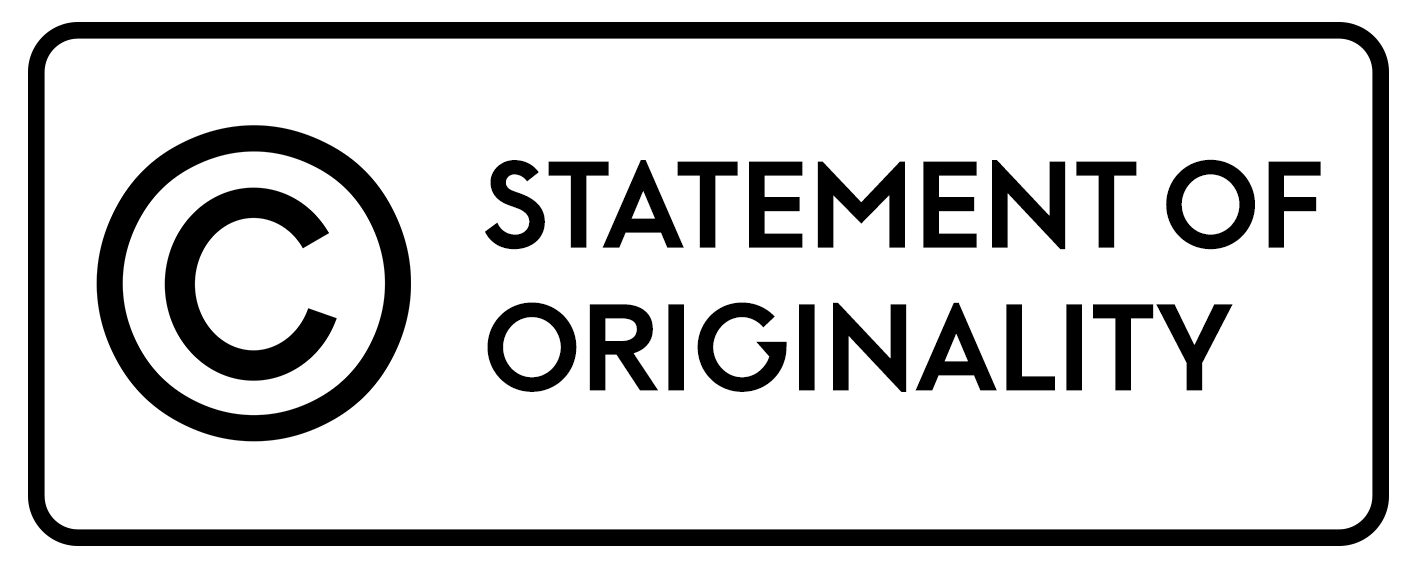From structure to ecology: Interpreting Greimas’s actantial model in the Anthropocene
Abstract
Keywords
Full Text:
PDFReferences
Abas, A., Aziz, A., & Awang, A. (2022). A systematic review on the local wisdom of indigenous people in nature conservation. Sustainability, 14(6), 3415. https://doi.org/10.3390/SU14063415
Al-Khalidi, I. (2023). Environmental literature and the importance of nature in writing. Journal of Literature and Linguistics Studies, 1(1), 1–8. https://doi.org/10.61424/jlls.v1i1.26
Alex, R. K. (2022). Indigenous naturecultures: Ecocosmopolitanism in Northeast Indian poetry. In P. Remien & S. Slovic (Eds.), Nature and literary studies (pp. 193–201). Cambridge University Press. https://doi.org/10.1017/9781108872263.013
Ampleman, L., & Vries, W. T. de. (2024). Reframing resilience narratives for (rural) communities using the actantial model. Sustainability, 16(12), 5219. https://doi.org/10.3390/su16125219
Ansori, S. (2023). Retelling environmental narratives in Indonesia: A prologue. Antropologi Indonesia, 44(2), 1–6. https://doi.org/10.7454/jai.v44i2.1024
Astuti, S., & Taum, Y. Y. (2017). When the earth conquers the heaven: A study of narratology on Kana Inai Abang Nguak in the perspective of A. J. Greimas. International Journal of Humanity Studies, 1(1), 1–16. https://doi.org/10.24071/ijhs.2017.010101
Baldassano, C., Chen, J., Zadbood, A., Pillow, J. W., Hasson, U., & Norman, K. A. (2017). Discovering event structure in continuous narrative perception and memory. Neuron, 95(3), 709-721.e5. https://doi.org/10.1016/J.NEURON.2017.06.041
Bertrand, D. (2019). From narratology to narrativity, and back: Assessment and perspectives of Greimassian theory. Pratiques: Linguistique, Littérature, Didactique, 181–182. https://doi.org/10.4000/pratiques.10348
Bloor, T., & Bloor, M. (2004). The functional analysis of English (2nd ed.). Arnold.
Borlik, T. A. (2011). Ecocriticism and early modern English literature: Green pastures (1st ed.). Routledge. https://doi.org/10.4324/9780203819241
Buell, L., Heise, U. K., & Thornber, K. (2011). Literature and environment. Annual Review of Environment and Resources, 36, 417–440. https://doi.org/10.1146/annurev-environ-111109-144855
Burke, A., & Fishel, S. (2019). Power, world politics, and thing-systems in the Anthropocene. In F. Biermann & E. Lövbrand (Eds.), Anthropocene encounters new directions in green political thinking (pp. 87–108). Cambridge University Press. https://doi.org/10.1017/9781108646673.005
Cameron, L. (2022). Indigenous ecological knowledge systems: Exploring sensory narratives. Ecological Management & Restoration, 23(S1), 27–32. https://doi.org/10.1111/emr.12534
Çanakplnar, B., Kalelioǧlu, M., & Günay, V. D. (2024). Political discourse and semiotics. Chinese Semiotic Studies, 20(2), 255–272. https://doi.org/10.1515/css-2024-2014
Caracciolo, M. (2021). Narrating the mesh: Form and story in the Anthropocene. University of Virginia Press.
Chang, S.-H.-E., Benjamin, E. O., & Sauer, J. (2024). Factors influencing the adoption of sustainable agricultural practices for rice cultivation in Southeast Asia: A review. Agronomy for Sustainable Development, 44, 27. https://doi.org/10.1007/s13593-024-00960-w
Clark, T. (2015). Ecocriticism on the edge: The Anthropocene as a threshold concept. Bloomsbury Academic.
Clark, T. (2019). The value of ecocriticism. Cambridge University Press. https://doi.org/10.1017/9781316155073
Clegg, S. R. (1993). Narrative, power, and social theory. In D. K. Mumby (Ed.), Narrative and Social Control: Critical Perspective (pp. 15–45). SAGE Publications.
Clegg, S. R. (2023). Frameworks of power. SAGE Publications.
Dennet, D. C., & Caruso, G. D. (2021). Just deserts: Debating free will. Polity Press.
Dewi, N. (2017). People and nature in Asian stories: reading and writing materials for eco education. K@ta: A Biannual Publication on the Study of Language and Literature, 19(1), 32–40. https://doi.org/10.9744/KATA.19.1.32-40
Diansyah, W., Abas, A., & Sakawi, Z. (2021). A systematic review on community forest management in Southeast Asia: Current practices and impacts on biodiversity conservation and livelihood quality of local communities. Human Ecology Review, 27(1), 3–21. https://search.informit.org/doi/10.3316/informit.280141055303355
Dürbeck, G. (2020). Narratives of the Anthropocene: From the perspective of postcolonial ecocriticism and environmental humanities. In M. Albrecht (Ed.), Postcolonialism cross-examined: Multidirectional perspectives on imperial and colonial pasts and the neocolonial present (pp. 271–288). Routledge.
Eco, U. (1979). A theory of semiotics. Indiana University Press.
Ellen, R. (2007). Introduction. In R. Ellen (Ed.), Modern crises and traditional strategies: Local ecological knowledge in island Southeast Asia (pp. 1–45). Berghahn Books.
Fisher, M., Maryudi, A., & Sahide, M. A. K. (2017). Forest and society: Initiating a Southeast Asia journal for theoretical, empirical, and regional scholarship. Forest and Society, 1(1), 1–7. https://doi.org/10.24259/fs.v1i1.1369
Halliday, M. A. K., & Matthiessen, C. M. I. M. (2014). Halliday’s introduction to functional grammar (4th ed.). Routledge.
Handayani, I. P., & Prawito, P. (2009). Indigenous soil knowledge for sustainable agriculture. In E. Lichtfouse (Ed.), Sociology, organic farming, climate change and soil science (Sustainabl, pp. 303–317). Springer, Dordrecht. https://doi.org/10.1007/978-90-481-3333-8_11
Harre, O. T., Laursen, L. H., Andersen, H. J., Neuhoff, R., & Simeone, L. (2024). Framing artistic practices through new materialism to ensure multispecies futuring in the built environment. Futures, 166, 103532. https://doi.org/10.1016/j.futures.2024.103532
Hebbar P, V., & Mallya, A. G. (2024). Exploring eco criticism: Interdisciplinary perspectives on literature and the environment. International Journal of Research and Analytical Reviews (IJRAR), 11(1), 69–73.
Helenius, T. (2021). Paul Ricœur: A phenomenology hermeneutics of meaningful action. In E. Christopher & T. Keiling (Eds.), The Routledge handbook of phenomenology of agency (pp. 189–207). Routledge.
Hofman-Bergholm, M. (2023). Storytelling: The ancient tool of using stories to communicate knowledge for a sustainable future. In N. Rezaei (Ed.), Integrated education and learning (Integrated Science, Vol. 13, pp. 237–253). Springer, Cham. https://doi.org/10.1007/978-3-031-15963-3_14
Holt, L., & Perry, J. (2023). Shaping the narratives—indigenous knowledges through storying. In M. Vicars & L. Pelosi (Eds.), Storying pedagogy as critical praxis in the neoliberal university: Encounters and disruptions (pp. 29–47). Springer Nature Singapore.
James, E., & Morel, E. (2018). Ecocriticism and narrative theory: An introduction. English Studies, 99(4), 355–365. https://doi.org/10.1080/0013838X.2018.1465255
Kadiresan, K., & Khanal, P. R. (2018). Rethinking irrigation for global food security. Irrigation and Drainage, 67(1), 8–11. https://doi.org/10.1002/ird.2219
Kakoty, S. (2018). Ecology, sustainability and traditional wisdom. Journal of Cleaner Production, 172, 3215–3224. https://doi.org/10.1016/j.jclepro.2017.11.036
Kautz, A. (2024). View of humanising the nonhuman: An ecocritical toolbox for anthropomorphic agency. Ecozon@, 15(2), 173–188. https://doi.org/10.37536/ecozona.2024.15.2.4813
Kovach, M. (2021). Indigenous methodologies: Characteristics, conversations, and contexts (2nd ed.). University of Toronto Press.
Kublikowski, I. (2023). Reflections on analysis in qualitative research: The hermeneutic circle in Ricoeur. Paidéia (Ribeirão Preto), 33, e3319. https://doi.org/10.1590/1982-4327e3319
Ladzekpo, G. K., Amekor, C. K., & Davi, S. K. (2024). The power of storytelling and narrative in literature and cultural identity: A review article. British Journal of Humanities and Social Sciences, 1(1), 20–31. 10.61424/bjhss.v1i1.156
Lambropoulos, N. (2025). The art and practice of creative storytelling. Cambridge Scholars Publishing.
Landowski, E. (2015). The Greimassian semiotic circle. In M. Grishakova & S. Salupere (Eds.), Theoretical schools and circles in the twentieth-century humanities: Literary theory, history, philosophy (pp. 84–98). Taylor and Francis Inc. https://doi.org/10.4324/9781315752914-5
Latour, B. (2005). Reassenbling the social: An introduction to actor-network-theory. Oxford University Press.
Lee, D. (2022). Wilderness. In P. Remien & S. Slovic (Eds.), Nature and literary studies (pp. 65–86). Cambridge University Press.
Lee, H. (2024). The antinomy of the Anthropocene: The narrative of enlightenment in Dipesh Chakrabarty’s ecological theory. Theory, Culture and Society, 41(4), 75–93. https://doi.org/10.1177/0263276424123899
Lejot, E. (2017). Requests for help in a multilingual professional environment testimonies and actantial models. Open Linguistics, 3(1), 516–539. https://doi.org/10.1515/opli-2017-0026
Lorusso, A. M. (2015). Cultural semiotics : For a cultural perspective in semiotics (1st ed.). Palgrave Macmillan.
MacAvoy, L. (2016). Distanciation and epoché: The influence of Husserl on Ricoeur’s hermeneutics. In S. Davidson & M.-A. Vallée (Eds.), Hermeneutics and phenomenology in Paul Ricoeur: Between text and phenomenon (pp. 13–30). Springer.
Matthiessen, C. M. I. M., & Teruya, K. (2024). Systemic functional linguistics: A complete guide. Routledge.
Max, J. I. S. D. (2020). Baraa’ Hudo’ Kawit: From folklore to collective belief. In M. Sutrisno, S. J. Suyono, & I. Muhtarom (Eds.), Kebertuhanan dalam kebudayaan nusantara (pp. 163–184). Borobudur Writers and Cultural Festival (BWCF) Society. https://www.researchgate.net/publication/378900307_Baraa’_Hudo’_Kawit_From_Folklore_to_Collective_Belief
Max, J. I. S. D., Kuncara, S. D., Sudirman, E. P., Nugroho, B. A., Alamsyah, Manggala, S. A., & Peterianus, S. (2025). The representation of nature in a political speech in promoting “Indonesia Maju.” Visions for Sustainability, 23(1), 1–30. https://doi.org/10.13135/2384-8677/11523
Max, J. I. S. D., Sirimorok, N., Vivian, Y. I., Dahlan, D., Alamsyah, Nugroho, B. A., Huan, O. L., & Hilah, V. F. (2025). Circular commoning: Dayak Bahau in the middle of political and ecological change. Forest and Society, 9(1), 103–132. https://doi.org/10.24259/fs.v9i1.36920
Max, J. I. S. D., & Zamruddin, M. P. (2020). Lack of actor in the State Address of Indonesian President on the 74th Indonesia Independence Day. Journal of Language and Literature, 20(2), 231–241. https://doi.org/10.24071/joll.v20i2.2632
Mazzocchi, F. (2020). A deeper meaning of sustainability: Insights from indigenous knowledge. The Anthropocene Review, 7(1), 1–17. https://doi.org/10.1177/2053019619898888
McAllister, B. J. (2024). Landscape rhetoricity: Narrative, ecology, and topographic form. Narrative, 32(4), 244–259. https://dx.doi.org/10.1353/nar.00002
Mei, T. S. (2016). Constructing Ricoeur’s hermeneutical theory of truth. In S. Davidson & M.-A. Vallée (Eds.), Hermeneutics and phenomenology in Paul Ricoeur: Between text and phenomenon (pp. 197–215). Springer.
Mussi, F. (2024). “Don’t bother the earth spirit […] she is working on a story”: Indigenous perspectives on human-land relations. In F. Mussi (Ed.), Indigenous storytelling and connections to the land: More-than-human worlds (pp. 1–27). Palgrave Macmillan. https://doi.org/10.1007/978-3-031-65591-3
Nanson, A. (2021). Storytelling and ecology: Empathy, enchantment, and emergence in the use of oral narratives. Bloomsbury Academic.
Nensilianti, N., Hajrah, H., Ridwan, R., & Jabu, B. (2025). Decoding the narrative syntax and macrostructure of Toraja folklore: A quest for meaning. Journal of Language Teaching and Research, 16(2), 493–504. https://doi.org/doi.org/10.17507/jltr.1602.15
Norton, M. B. (2025). Anthropocene religion: Rethinking nature, humanity, and divinity amid climate catasthrope. Edinburgh University Press.
Oppermann, S. (2014). From ecological postmodernism to material ecocriticism: Creative materiality and narrative Agency. In S. Iovino & S. Oppermann (Eds.), Material ecocriticism (pp. 21–36). Indiana University Press.
Peverini, P. (2024). Bruno Latour in the semiotic turn: An inquiry into the networks of meaning. Springer.
Pham, C. P., Sankaran, C., & Kaur, G. (2019). Bonding ASEAN together through literary studies, ecological criticism, and the environmental humanities. In C. P. Pham, C. Sankaran, & G. Kaur (Eds.), Ecologies in Southeast Asian literatures: Histories, Myths and societies (pp. 1–8). Vernon Press.
Piercey, R. (2024). Is Paul Ricoeur still relevant to the philosophy of history? Rethinking History, 28(4), 532–557. https://doi.org/10.1080/13642529.2024.2431762
Rafique, Z., Hatta, Z. A., & Habib, S. (2024). A framework for understanding Asian Nations’ perspectives in social research: Epistemology of the South. In Reviving and re-writing ethics in social research for commoning the community (pp. 1–19). IGI Global. https://doi.org/10.4018/978-1-6684-8526-2.ch001
Rerkasem, K., Yimyam, N., & Rerkasem, B. (2009). Land use transformation in the mountainous mainland Southeast Asia region and the role of indigenous knowledge and skills in forest management. Forest Ecology and Management, 257(10), 2035–2043. https://doi.org/10.1016/j.foreco.2008.11.008
Ricoeur, P. (1976). Interpretation theory: Discourse and the surplus of meaning. Texas Christian University Press.
Ricoeur, P. (1981). Hermeneutics and the human sciences: Essays on language, action and interpretation (J. B. Thompson (ed.)). Cambridge University Press.
Ricoeur, P. (1985). The text as dynamic identity. In M. J. Valdes & O. Miller (Eds.), Identity of the literary text (pp. 175–186). University of Toronto Press.
Ritivoi, A. D. (2006). Paul Ricoeur: Tradition and innovation in rhetorical theory. State University of New York Press.
Ryan, J. C. (2019). Plants, people and narratives in Southeast Asia: Reading Kampoon Boontawee’s A Child of the Northeast as literary ethnobotany. International Journal of Contemporary Humanities, 2(1), 1–14. https://www.amkrpub.com/uploadfile/202309/237bb6abfd2dba1.pdf
Ryan, M.-L., & Weisheng, T. (2024). Object-oriented narratology. University of Nebraska Press.
Schleifer, R. (2017). A. J. Greimas and the nature of meaning: Linguistics, semiotics, and discourse theory. Routledge.
Seli, S., Priyadi, A. T., Saman, S., & Salem, L. (2020). Narrative structure of the Ne’Baruakng Kulup story oral literature of Dayak Kanayatn: A study of actantial AJ Greimas. Journal of Education, Teaching, and Learning, 5(2), 332–339.
Smeets, R., Pourcq, M. De, & Bosch, A. van den. (2021). Modeling conflict: Representations of social groups in present-day Dutch literature. Journal of Cultural Analytics, 6(3), 1–31. https://doi.org/10.7910/DVN/JSKPQV
Soares, M. T. (2021). From Ricœurian hermeneutics to environmental hermeneutics. Space, landscape, and interpretation. Études Ricoeuriennes / Ricoeur Studies, 12(2). https://doi.org/10.5195/errs.2021.559
Stibbe, A. (2023). Econarrative: Ethics, ecology, and the search for new narratives to live by. Bloomsbury Publishing
Tait, A. (2023). Imagining longevity and sustainability in Walter Besant’s The Inner House and William Morris’s News from Nowhere. In N. W. Balestrini, J. Hoydis, A.-C. Kainradl, & U. Kriebernegg (Eds.), Aging studies and ecocriticism: Interdisciplinary encounters (pp. 119–132). Lexington Books.
Tajane, S. S., Shree, V. B., Pathak, P., Saluja, V. K., & Srikanth, U. (2024). Ecocriticism In literature: Examining nature and the environment in literary works. Educational Administration: Theory and Practice, 30(6), 2162–2168. https://doi.org/10.53555/kuey.v30i6.5675
Talgorn, E., & Ullerup, H. (2023). Invoking ‘Empathy for the Planet’ through participatory ecological storytelling: From human-centered to planet-centered design. Sustainability, 15, 7794. 10.3390/su15107794
Tempone-Wiltshire, J. (2024). Sand talk: process philosophy and indigenous knowledges. Process Studies, 53(1), 42–68. https://doi.org/10.5406/21543682.53.1.02
Thomalla, F., Lebel, L., Boyland, M., Marks, D., Kimkong, H., Tan, S. B., & Nugroho, A. (2018). Long-term recovery narratives following major disasters in Southeast Asia. Regional Environmental Change, 1211–1222. https://doi.org/10.1007/s10113-017-1260-z
Thompson, J. (2018). Joyfully living an integral ecology: Indigenous narratives and their contribution to the dialogue on well-being. The Heythrop Journal, 59(6), 969–982. https://doi.org/10.1111/heyj.13019
Utsler, D. (2024). Paul Ricoeur and environmental philosophy. Lexington Books.
Verbivska, O. (2022). Comparative analysis of semiotic approaches to the notion of textual communication between an author and a reader (A. J. Greimas, F. Rastier, J. Kristeva). Bulletin of Taras Shevchenko National University of Kyiv, 2(7), 5–9. https://doi.org/0.17721/2523-4064.2022/7-1/11
Vidal, D. G., Alves, F., Valentim, C. S., & Freitas, H. (2024). Natures instead of nature—plural perceptions and representations of nature and its challenges for ecological transition: a systematic review of the scientific production. Environmental Sciences Europe, 36(1), 1–24. https://doi.org/10.1186/S12302-024-00934-5
Walsh, J., Vaida, N., Coman, A., & Fiske, S. T. (2022). Stories in action. Psychological Science in the Public Interest, 23(3), 99–141. https://doi.org/10.1177/15291006231161337/ASSET/6C3AA61E-9381-414F-89B2-633737AD6BF1/ASSETS/IMAGES/LARGE/10.1177_15291006231161337-FIG7.JPG
Wang, Y., & Roberts, C. W. (2005). Actantial analysis: Greimas’s structural approach to the analysis of self-narratives. Narrative Inquiry, 15(1), 51–74. https://doi.org/https://doi.org/10.1075/ni.15.1.04wan
Wardarita, R., & Negoro, G. P. (2017). A comparative study: The folktale of Jaka Tarub (Indonesia) and Tanabata (Japan). Advances in Language and Literary Studies, 8(6), 1–6.
Wejak, J. (2023). Indigenous knowledge is key to better managing water in Indonesia. Melbourne Asia Review, 15. https://doi.org/10.37839/MAR2652-550X15.1
Yadav, C., & Sinha, J. (2024). Exploring the evolution of ecocriticism: A bibliometric study and literature review. Multidisciplinary Reviews, 7(12), 2024304. https://doi.org/10.31893/multirev.2024304
Zalasiewicz, J., Thomas, J. A., Waters, C. N., Turner, S., & Head, M. J. (2024). The meaning of the Anthropocene: Why it matters even without a formal geological definition. Nature, 632, 980–984. https://doi.org/10.1038/d41586-024-02712-y
DOI: http://dx.doi.org/10.30872/calls.v11i0.22569
Copyright (c) 2025 Jonathan Irene Sartika Dewi Max, Setya Ariani

This work is licensed under a Creative Commons Attribution-ShareAlike 4.0 International License.
Editorial address:
Fakultas Ilmu Budaya, Universitas Mulawarman
Address: Jl. Ki Hajar Dewantara, Gunung Kelua, Kec. Samarinda Ulu, Kota Samarinda, Kalimantan Timur, Indonesia 75123
Email: jurnalcalls@fib.unmul.ac.id
Website: http://e-journals.unmul.ac.id/index.php/CALLS

CaLLs: Journal of Culture, Arts, Literature, and Linguistics site is licensed under a Creative Commons Attribution-ShareAlike 4.0 International License
CaLLs: Journal of Culture, Arts, Literature, and Linguistics indexing by:















